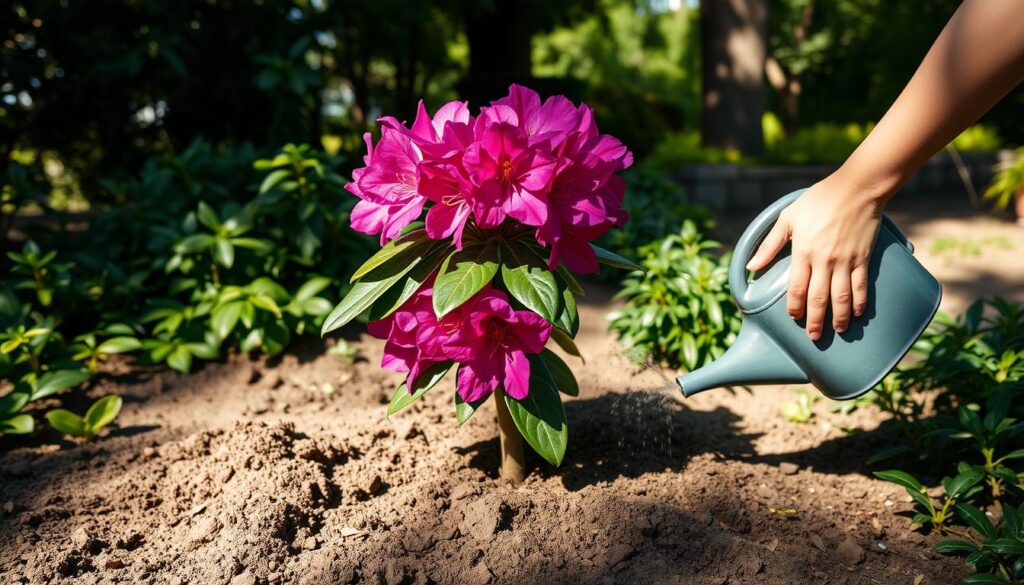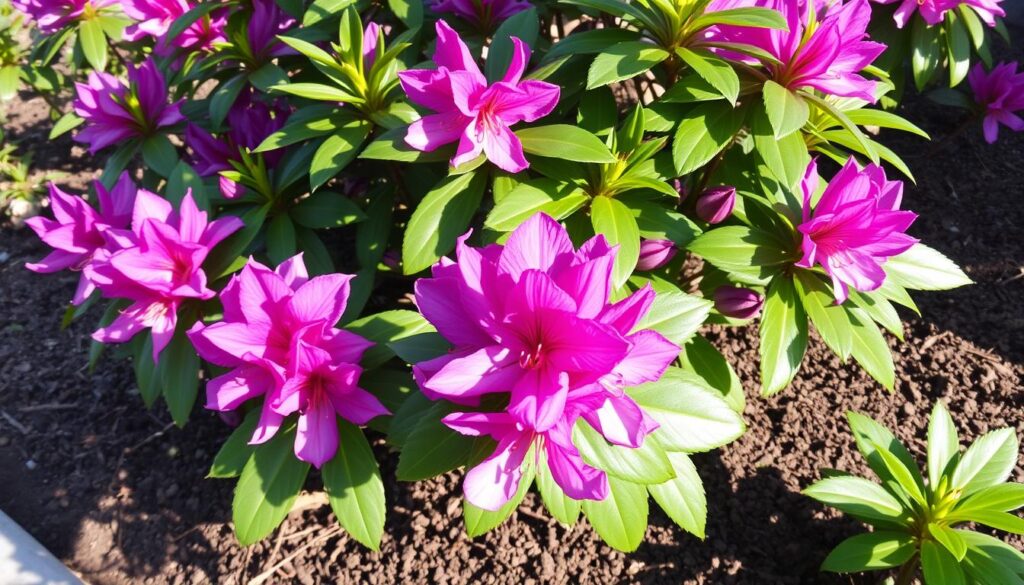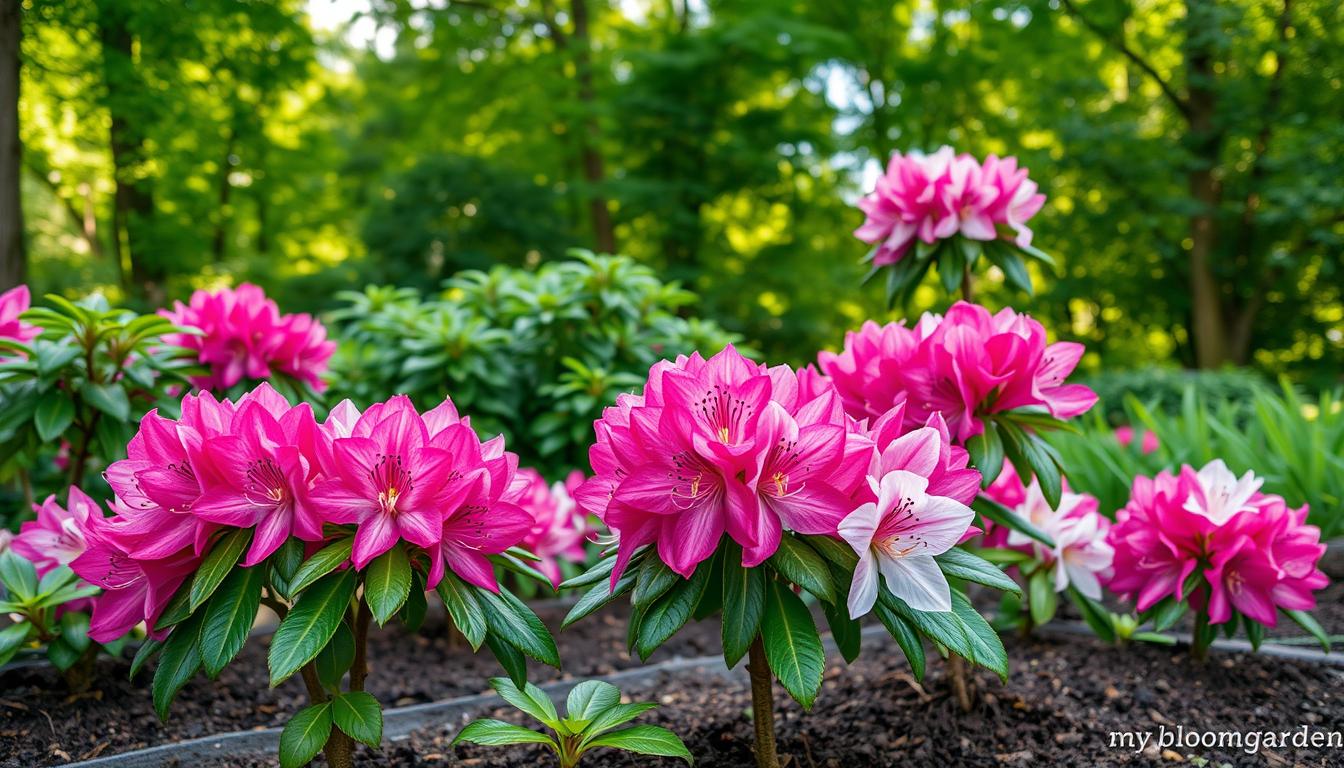As I walk through my garden, the bright, bell-shaped flowers of my rhododendrons catch my eye. These beautiful shrubs have become a favorite in my garden. I’m excited to share how to grow them well with you.
Whether you’re an experienced gardener or new to rhododendrons, this guide has everything you need. It will help you plant and care for these amazing plants in your garden.
Table of Contents
Understanding Rhododendron Basics and Benefits
Rhododendrons are stunning flowering shrubs that attract many gardeners and landscapers. They come in various sizes, shapes, and colors. This makes them a favorite for enhancing outdoor spaces. Let’s explore the world of rhododendrons and their special benefits.
Different Types of Rhododendrons
There are over 1,000 species and countless cultivars of rhododendrons. They range from tall, tree-like plants to small, dwarf varieties. You can find everything from evergreen rhododendrons to deciduous azaleas and compact bushes. Each type has its own unique foliage, bloom patterns, and growth habits. This lets you pick the perfect rhododendron for your garden.
Key Benefits of Growing Rhododendrons
Rhododendrons are not just beautiful; they also have practical benefits. These hardy shrubs are known for their:
- Long-lasting, vibrant blooms that add elegance to any outdoor setting
- Ability to thrive in shady areas, making them versatile for landscaping
- Low maintenance requirements, saving time and effort
- Attractiveness to pollinators, like bees and hummingbirds, supporting a healthy ecosystem
Growth Characteristics and Mature Size
Rhododendrons vary in size, from small dwarfs to tall plants up to 30 feet tall. When choosing a rhododendron, consider its mature size and growth habits. This ensures it fits well in your landscape and doesn’t grow too big for its space.
“Rhododendrons are the aristocrats of the garden world, flaunting their bold, vibrant blooms with unparalleled elegance.”
Selecting the Perfect Location for Your Rhododendrons
Choosing the right spot for your rhododendrons is key to their success. You need to think about rhododendron light requirements, soil, and air flow. Let’s explore what’s important for the perfect spot.
Ideal Light Conditions
Rhododendrons love partial shade, avoiding direct sunlight, especially when it’s hot. A spot with dappled light or shade from trees is best. Too much sun can burn the leaves and slow growth. Make sure your chosen spot gets the right light for your rhododendrons.
Soil Requirements and Drainage
Rhododendrons need acidic, well-draining soil with lots of organic matter. Stay away from heavy clay or compacted soil. These can cause waterlogging, harming your plants. Test your soil’s pH and add compost or peat moss if needed.
Space and Air Circulation Needs
Rhododendrons need room to grow, both up and down. Pick a spot with enough space for the plant’s full size. Good air flow is crucial to prevent diseases and promote healthy growth.
By considering these factors, you can find the perfect spot for your rhododendrons. This will help them thrive in your garden for years to come.
“Choosing the right spot for your rhododendrons is the foundation for a thriving, lush garden.”
Best Time to Plant Rhododendrons
Timing is key when planting rhododendrons. The best season varies based on your local climate and soil. Generally, the best times are:
- Spring – Plant in early spring, after the last frost. This lets rhododendrons grow roots before summer.
- Fall – Autumn is also great for planting. Cooler weather and more rain help roots grow well.
It’s important to avoid planting in the hottest summer or coldest winter. Extreme weather can harm their roots and health.
When planning your garden, consider your local weather. Things like elevation, sun, and soil affect the best planting time. Talking to local nurseries or extension services can guide you.
“The secret to successful rhodedendron planting lies in understanding the unique needs of these finicky plants and timing their introduction to your garden with care.”
By planting at the right time, you’ll help your rhododendrons thrive. They’ll beautify your landscape for many years.
How to Plant Rhododendron: Step-by-Step Instructions
Planting your rhododendron right is key for its health in your garden. Follow this guide to help your new shrub start strong.
Preparing the Planting Hole
Start by digging a hole that’s two to three times wider than the root ball. But don’t make it too deep. A wide, shallow hole lets the roots spread out well. Make sure the hole’s sides slope, not straight.
Setting the Root Ball
Be gentle when taking the rhododendron out of its container. This helps avoid damaging the roots. Put the plant in the hole’s center, making sure the root ball’s top is level with the soil. Don’t plant it too deep, as this can cause problems later.
Backfilling and Mulching
- Gently fill the hole with the original soil, avoiding too much compaction.
- After filling, create a shallow basin around the plant to help water reach the roots.
- Apply a 2-4 inch layer of organic mulch, like bark chips or pine needles, around the plant. This keeps moisture in and weeds out.
By following these how to plant rhododendron steps, you’ll give your new rhododendron a great start. Remember, good garden practice is crucial for healthy, vibrant rhododendrons.
“Rhododendrons are a beautiful addition to any garden, but proper planting is essential for their success.”
Essential Soil Preparation Techniques
For healthy rhododendron plants, the right soil is key. They love acidic, well-draining soil. So, it’s important to make the perfect soil for these colorful plants.
Adjusting the soil’s pH is a big step. Rhododendrons need a slightly acidic soil, with a pH between 4.5 and 6.0. You can test your soil and adjust it with sulfur or aluminum sulfate if it’s too high.
Adding organic matter is also vital. Compost, peat moss, or leaf litter improve soil structure and drainage. Mix 2-4 inches of it into the top 8-12 inches of soil before planting.
Good drainage is crucial for rhododendrons. If your soil drains poorly, add sand or gravel. Raised beds or mounds can also help with drainage.
By preparing the soil well, you’ll ensure your rhododendrons thrive. They’ll grow strong and colorful in your garden.
Watering and Moisture Management
Proper watering is key for your rhododendrons to thrive. Whether you’re planting new ones or caring for the old, knowing their water needs is vital. This ensures they grow healthy and strong.
Initial Watering Guidelines
When planting rhododendrons, they need lots of water to grow roots. Water them deeply until the soil is moist but not too wet. For the first few weeks, keep the soil moist but not soggy.
Long-term Irrigation Needs
As rhododendrons grow, their water needs change. Mature plants need about 1 to 2 inches of water a week. This can come from rain or extra watering. Adjust your watering based on soil moisture, weather, and your plants’ specific needs.
Managing Water During Different Seasons
- Spring and Fall: These seasons are when rhododendrons grow the most. Keep the soil moist during these times.
- Summer: Water more during hot, dry weather to prevent wilting and moisture stress.
- Winter: Water less as rhododendrons are dormant and need less moisture. But don’t let the soil dry out completely.
By following these watering tips, your rhododendrons will flourish. They’ll bloom beautifully and stay lush for many years.

Remember, keeping the soil moist all year is crucial for rhododendron care. Adjust your watering as the seasons change and based on your plants’ needs.
Fertilizing and Feeding Requirements
Proper fertilization is key for your rhododendrons’ health and blooms. These plants need specific nutrients to thrive. Let’s look at the best ways to fertilize your rhododendrons.
Rhododendrons need a balanced fertilizer with the right mix of nitrogen, phosphorus, and potassium. Use a slow-release or granular fertilizer in early spring. This gives them nutrients all growing season. It helps with strong roots, lush leaves, and lots of flowers.
You can also use organic options like compost, peat moss, or well-rotted manure. These not only feed your rhododendrons but also make the soil better. They help with water and nutrient retention, creating a perfect growing spot.
- Apply a balanced rhododendron-specific fertilizer in early spring, following the manufacturer’s instructions.
- Use a slow-release or granular formulation to provide a steady supply of nutrients over time.
- Incorporate organic matter like compost or well-rotted manure into the soil to enhance overall plant health.
Consistent and proper fertilization is crucial for your rhododendrons’ beauty. By giving them the right nutrients at the right time, you’ll get vibrant, healthy plants. These will bring joy to your garden for many years.
Common Problems and Solutions
Caring for your rhododendron plants can be rewarding but comes with challenges. You might face fungal diseases or pest infestations. It’s key to tackle these problems early to keep your garden practice thriving.
Disease Prevention
Chlorosis is a common issue with rhododendrons, causing yellow leaves due to iron deficiency. Regular soil tests and adding the right nutrients can prevent this. Also, watch out for leaf spot and fungal dieback, which can be controlled with fungicides.
Pest Control Methods
Insect pests like aphids and lace bugs can harm your rhododendron plants. Keep an eye on your plants and deal with infestations quickly. Using insecticidal soaps or oils can help control these pests. Good air circulation around your plants can also keep many garden insects away.
Troubleshooting Growth Issues
- Curled leaves often mean frost damage or dryness. Use anti-desiccants or protect plants in winter.
- Lichen on bark suggests poor air or drainage. Fix this with pruning and soil changes.
- Root rot from too much water or bad drainage can be fixed by repotting in better soil and adjusting water.
“Proactive care and timely problem-solving are the keys to maintaining healthy, thriving rhododendron plants.”
Stay alert and solve problems fast to keep your garden practice with rhododendron plants successful and fun. With the right methods, your rhododendrons will stay beautiful for many years.

Conclusion
Congratulations on starting your journey with rhododendrons! You’ve learned how to plant and care for them. This guide has given you the steps to grow these beautiful shrubs in your garden.
From the basics to how to keep them healthy, you’re ready. You know how to pick the best spot, plant them right, and take care of them. Now, you can make your garden look amazing with rhododendrons.
Growing rhododendrons comes with many benefits. They add color and greenery to your garden. They also make your outdoor space look better.
As you use what you’ve learned, you’ll enjoy your garden more. Rhododendrons bring beauty and peace to your garden. They will make it special for years.
With the right care, your rhododendrons will flourish. Enjoy gardening and let these plants be a highlight of your garden. Happy planting!

